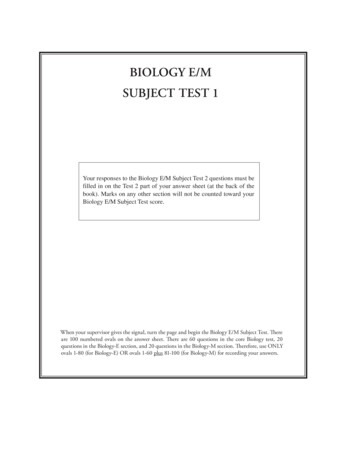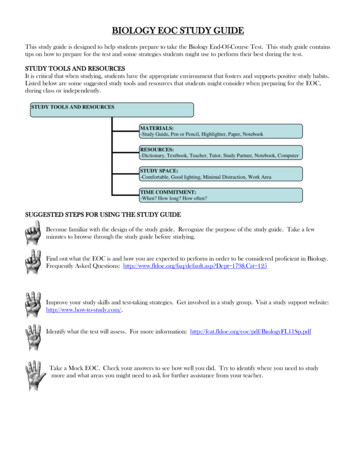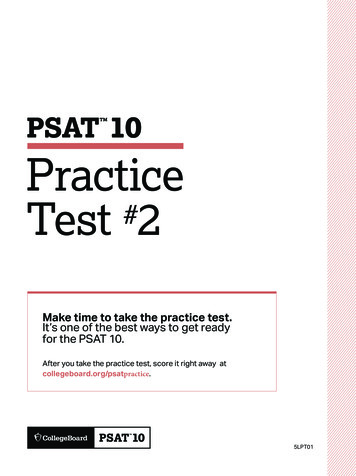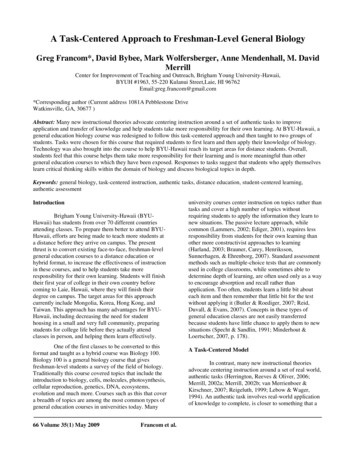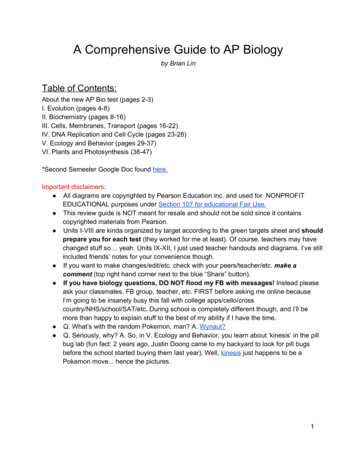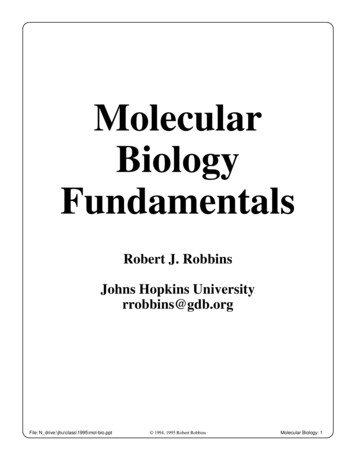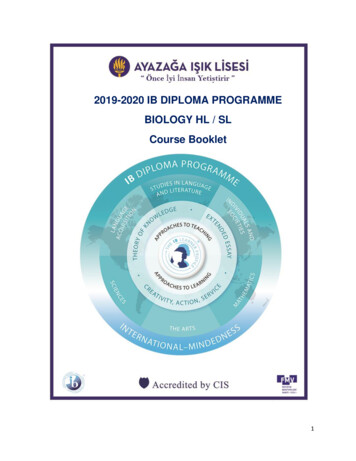
Transcription
Tennessee ComprehensiveAssessment ProgramTCAPBiologyPractice TestPlease PRINT all information in the box.Student Name:Teacher Name:School:District:All practice test items represent the appropriate grade level/content standards—however, thepractice test may contain item types that no longer appear on the operational assessment.
Published under contract with the Tennessee Department of Education by Educational Testing Service (ETS), Princeton, NJ 08541. Copyright 2019 byTennessee Department of Education. All rights reserved. No part of this publication may be copied, reproduced, or distributed in any form or by any means,or stored in a database or retrieval system, without the prior express written consent of the Tennessee Department of Education.
TCAP EOC Biology08/14/2019 [This header should NOT be printed.]TCAP FA19 EOC SCI BIO PT rev02SAMPLE QUESTIONSAMPLE QUESTIONDirectionsRead the sample and mark the correct answer.Do not go on to the next page until told to do so.SECURE MATERIALASSESSMENTMATERIALDo not reproduceor discuss contentsMay only be reproduced for classroom use11 Go onSTOP
TCAP EOC Biology07/24/2019 [This header should NOT be printed.]TCAP FA19 EOC SCI BIO PT rev00Biology1. Which change in DNA will cause a heritable germline mutation?A.The sugar phosphate backbone of DNA in bone cells breaks due toexposure to X-rays.B.Thymine dimers form in the DNA of a skin cell due to exposure to UVlight.C.A DNA replication error occurs in a sperm-producing cell.D.An error occurs during transcription of the DNA in a liver cell.SECURE MATERIALASSESSMENTMATERIALDonot reproduceor discuss contentsMay only be reproduced for classroom use12Go on
TCAP EOC Biology07/24/2019 [This header should NOT be printed.]TCAP FA19 EOC SCI BIO PT rev00Biology2. A student is investigating how substrate concentration affects therate of an enzyme-catalyzed reaction. Which three variables shouldbe kept constant in the setup of the student’s investigation?M. temperature of the reactionP.amount of enzymeR.amount of substrateS.amount of productT.pH of the reactionSECURE MATERIALASSESSMENTMATERIALDo not reproduceor discuss contentsMay only be reproduced for classroom use23Go on
TCAP EOC Biology07/24/2019 [This header should NOT be printed.]TCAP FA19 EOC SCI BIO PT rev00Biology3. Tupai is part of the Leeward Islands. For years, people were notallowed on this island. Recently, it has been opened to tourists. Howwill increased development and human interactions likely affectsuccession on this island?A.Lichens will increase quickly, creating a climax community.B.Mature trees will decrease, creating a pioneer community.C.Biodiversity will decrease as the number of species decreases.D.More diverse species will move into the area as biodiversity increases.SECURE MATERIALASSESSMENTMATERIALDonot reproduceor discuss contentsMay only be reproduced for classroom use34Go on
TCAP EOC Biology07/24/2019 [This header should NOT be printed.]TCAP FA19 EOC SCI BIO PT rev00Biology4. A cell model is shown. Students were instructed to review the typesand number of structures that are present in this cell model.Which three cell types could be represented by the model?M. human stem cellP.plant xylem cellR.bacterial cellS.sea urchin embryo cellT.mammalian white blood cellSECURE MATERIALASSESSMENTMATERIALDo not reproduceor discuss contentsMay only be reproduced for classroom use45Go on
TCAP EOC Biology07/24/2019 [This header should NOT be printed.]TCAP FA19 EOC SCI BIO PT rev00Biology5. Two dogs are shown.Which claim about reproduction in dogs can best be supportedusing a valid argument?A.Offspring produced by sexual reproduction are genetically identical.B.Gametes from both dogs are needed to maintain the correct number ofchromosomes in the offspring.C.Phenotypic variation will occur in the offspring as a result of mitosis inthe gametes.D.Binary fission is required for sexual and asexual reproduction in dogs.SECURE MATERIALASSESSMENTMATERIALDonot reproduceor discuss contentsMay only be reproduced for classroom use56Go on
TCAP EOC Biology07/24/2019 [This header should NOT be printed.]TCAP FA19 EOC SCI BIO PT rev00Biology6. This diagram illustrates the carbon cycle.Which change would lead to higher carbon dioxide levels in theatmosphere?M. an increase in photosynthesisP.a decrease in animal respirationR.an increase in the burning of fossil fuelsS.a decrease in the destruction of forestsSECURE MATERIALASSESSMENTMATERIALDo not reproduceor discuss contentsMay only be reproduced for classroom use67Go on
TCAP EOC Biology07/24/2019 [This header should NOT be printed.]TCAP FA19 EOC SCI BIO PT rev00BiologyQuestions 7 – 10 refer to the passage(s) and image(s) shown.Photosynthetic Slugs – Part 1The green sea slug, Elysia chlorotica, is a soft-bodied marine animal that lives off theeastern coast of North America in the Atlantic Ocean. The green sea slug feeds on algae.It is able to use chloroplasts from the algae, Vaucheria litorea, to performphotosynthesis and produce its own food. A young green sea slug is able to survive fornine months after feeding one time on V. litorea.It has been hypothesized that as the green sea slug feeds on V. litorea, it takes thechloroplasts from the algae. For the chloroplasts to continue working in the green seaslug, the green sea slug incorporates the algal genes that are needed to performphotosynthesis into its own DNA. This allows the green sea slug to produce the proteinsneeded for the chloroplasts to continue working due to common ancestry.A diagram of the life cycle for E. chlorotica is shown.To investigate the slugs’ ability to survive without food, researchers measured oxygendynamics in mature E. chlorotica in culture after they had fed on V. litorea. The resultsof the investigation are shown in the graph.SECURE MATERIALASSESSMENTMATERIALDonot reproduceor discuss contentsMay only be reproduced for classroom use78Go on
TCAP EOC Biology07/24/2019 [This header should NOT be printed.]TCAP FA19 EOC SCI BIO PT rev00BiologySECURE MATERIALASSESSMENTMATERIALDo not reproduceor discuss contentsMay only be reproduced for classroom use89Go on
TCAP EOC Biology07/24/2019 [This header should NOT be printed.]TCAP FA19 EOC SCI BIO PT rev00Biology7. Which statement best explains how the green sea slug is able toproduce its own food?A.The slug is able to convert the oxygen needed for cellular respiration intoglucose in the chloroplasts.B.The slug is able to store the algae within its body and use the glucoseproduced by the algae for cellular respiration.C.The slug is able to use the chloroplasts to make glucose molecules that itthen uses for cellular respiration.D.The slug is able to perform cellular respiration to provide the carbondioxide needed for photosynthesis.8. Which property would give the green sea slug the capability toincorporate the genes of V. litorea into its own DNA?M. The green sea slug has the ability to replicate the algal DNA.P.The green sea slug has the ability to change its DNA to match the algalDNA.R.They both have the same number of chromosomes in their DNA.S.They both use the same nucleotides in their DNA.SECURE MATERIALASSESSMENTMATERIALDonot reproduceor discuss contentsMay only be reproduced for classroom use910Go on
TCAP EOC Biology07/24/2019 [This header should NOT be printed.]TCAP FA19 EOC SCI BIO PT rev00Biology9. In the investigation of oxygen dynamics in E. chlorotica cultures,gross photosynthesis is reported after seven months in culture, evenin the apparent absence of oxygen production.Which statement provides the best reasoning to explain thisobservation?A.The oxygen produced in photosynthesis is used in cellular respiration.B.Photosynthesis can be sustained in the absence of oxygen production.C.The plastids store oxygen for use in photosynthesis.D.The ability to carry out photosynthesis is transferred from thechloroplast to the mitochondria.10. Based on the model of the E. chlorotica life cycle, at which stage isthe organism most likely capable of carrying out photosynthesis?M. throughout its entire life cycleP.as a larvaR.as a nonpigmented juvenileS.as a pigmented adultSECURE MATERIALASSESSMENTMATERIALDo not reproduceor discuss contentsMay only be reproduced for classroom use1011Go on
TCAP EOC Biology07/24/2019 [This header should NOT be printed.]TCAP FA19 EOC SCI BIO PT rev00BiologyQuestions 11 and 12 refer to the passage(s) and image(s) shown.Photosynthetic Slugs – Part 2The algae Vaucheria litorea are able to carry out photosynthesis; however, isolatedchloroplasts from V. litorea are not. Researchers have determined that the DNA withinthe chloroplasts contains the genes required for photosynthesis. Many of the additionalgenes needed to sustain chloroplast function are located in the nucleus. To investigatethe genetic requirements for chloroplast function in the green sea slug, Elysia chlorotica,researchers sequenced the psbO gene found in V. litorea. The psbO gene encodes forpart of the water-splitting complex in the light-dependent reaction duringphotosynthesis. The researchers then determined which cells, cell parts, anddevelopmental stage of the green sea slug, if any, also contain this gene. The data fromtheir investigation are shown in the table.Presence of psbO Gene inV. litorea and E. chlorotica CellsOrganismArea StudiedpsbO DNASequence Present?V. litoreaWhole cellYesV. litoreaNucleusYesV. litoreaChloroplastNoV. litoreaMitochondriaNoE. chloroticaEggsYesE. chloroticaLarvaeYesE. chloroticaMature adultYesE. chloroticaNucleusYesE. chloroticaMitochondriaNoE. chloroticaCytoplasmNoSECURE MATERIALASSESSMENTMATERIALDonot reproduceor discuss contentsMay only be reproduced for classroom use1112Go on
TCAP EOC Biology07/24/2019 [This header should NOT be printed.]TCAP FA19 EOC SCI BIO PT rev00Biology11. Which claim is most consistent with the evidence that psbO DNAsequences are detected in E. chlorotica eggs?A.The psbO gene is transferred from V. litorea when it is consumed byE. chlorotica.B.The psbO gene was transferred from V. litorea to a recent ancestor ofE. chlorotica.C.The psbO gene independently evolved in response to selective pressurein an ancestor of E. chlorotica.D.The psbO gene is present in all organisms belonging to the samephylogenetic clade as E. chlorotica.12. Which statement correctly uses the data from the table to support aclaim that nuclear genes support chloroplast function in V. litorea?M. psbO DNA sequences are detected in the nucleus but not in chloroplasts.P.psbO mRNA is present in the cytoplasm.R.psbO sequences are found in many photosynthetic organisms.S.psbO sequences in V. litorea and E. chlorotica are very similar.SECURE MATERIALASSESSMENTMATERIALDo not reproduceor discuss contentsMay only be reproduced for classroom use1213Go on
TCAP EOC Biology07/24/2019 [This header should NOT be printed.]TCAP FA19 EOC SCI BIO PT rev00Biology13. An image of the carbon cycle is shown.Which action could lead to a reduction in atmospheric carbon?A.using coal to power a factoryB.burning logs in a fireplaceC.animals eating mushrooms in a fieldD.humans planting trees in a forestSECURE MATERIALASSESSMENTMATERIALDonot reproduceor discuss contentsMay only be reproduced for classroom use1314Go on
TCAP EOC Biology07/24/2019 [This header should NOT be printed.]TCAP FA19 EOC SCI BIO PT rev00Biology14. A model of a bee pollinating a flower is shown.Bees cross-pollinate flowers when moving from flower to flower toobtain nectar. Bees use the collected nectar to create honey. Whichthree ecosystem services are best represented by this model?M. provisioning services: goods provided by or produced by ecosystemsP.regulating services: benefits obtained from regulation of ecosystemservicesR.cultural services: nonmaterial benefits from ecosystemsS.supporting services: services necessary for production of otherecosystem servicesT.land use: clearing land for human housing developmentSECURE MATERIALASSESSMENTMATERIALDo not reproduceor discuss contentsMay only be reproduced for classroom use1415Go on
TCAP EOC Biology07/24/2019 [This header should NOT be printed.]TCAP FA19 EOC SCI BIO PT rev00Biology15. A model of ecological succession is shown.Which two natural events would lead to this type of succession?A.clear-cutting of a forestB.wind damage from a tornadoC.lava flow from a volcanoD.flooding with soil erosionE.retreat of a glacierSECURE MATERIALASSESSMENTMATERIALDonot reproduceor discuss contentsMay only be reproduced for classroom use1516Go on
TCAP EOC Biology08/06/2019 [This header should NOT be printed.]TCAP FA19 EOC SCI BIO PT rev01BiologyBiology16. The graph shows the average catch rates per hour of tiger sharks forvarious years between 1997 and 2007 in the Shark Bay ecosystem.Which claim about the shark population is best supported using thedata?M. More people fish for sharks in the winter than in the summer.P.Sharks have larger body sizes during the summer than during the winter.R.Sharks migrate northward from Shark Bay during the summer tomaintain a low body temperature.S.The population of sharks in Shark Bay is larger in the summer than inthe winter.SECURE MATERIALASSESSMENTMATERIALDo not reproduceor discuss contentsMay only be reproduced for classroom use1717Go on
TCAP EOC Biology07/24/2019 [This header should NOT be printed.]TCAP FA19 EOC SCI BIO PT rev00Biology17. Which three processes occur during meiosis?A.crossing overB.asexual reproductionC.formation of gametesD.independent assortmentE.production of diploid cellsSECURE MATERIALASSESSMENTMATERIALDonot reproduceor discuss contentsMay only be reproduced for classroom use1718Go on
TCAP EOC Biology07/24/2019 [This header should NOT be printed.]TCAP FA19 EOC SCI BIO PT rev00Biology18. Receptor tyrosine kinases (RTKs) are a class of membrane receptorthat, when bound by a specific signaling molecule, will enzymaticallyphosphorylate itself and initiate a response in the cell. A modelrepresenting RTK activation is shown.A researcher is planning an experiment to engineer a nonfunctionalversion of an RTK. Which engineered protein will most likely be anonfunctional RTK?M. an RTK protein with a second enzyme region in the cytosolic portion ofthe proteinP.an RTK protein that can phosphorylate itself even in the absence of thesignaling moleculeR.an RTK protein that is unable to bind to the signaling moleculeS.an RTK protein that has multiple phosphorylation sitesSECURE MATERIALASSESSMENTMATERIALDo not reproduceor discuss contentsMay only be reproduced for classroom use1819Go on
TCAP EOC Biology07/24/2019 [This header should NOT be printed.]TCAP FA19 EOC SCI BIO PT rev00Biology19. A removal of a dam in a river has restored river flow and improvedthe water quality of the river. Which of these would most directlyincrease due to the enhanced water quality in the river ecosystem?A.pollutionB.biodiversityC.death ratesD.global climate changeSECURE MATERIALASSESSMENTMATERIALDonot reproduceor discuss contentsMay only be reproduced for classroom use1920Go on
No test materialon this pageASSESSMENT MATERIALMay only be reproduced for classroom use21Go on
TCAP EOC Biology07/24/2019 [This header should NOT be printed.]TCAP FA19 EOC SCI BIO PT rev00BiologyQuestions 20 – 22 refer to the passage(s) and image(s) shown.Cyanogenic Clover – Part 1White clover plants have the ability to produce the toxin cyanide under certainconditions. One hypothesis proposes that producing cyanide protects plants fromherbivores such as insects, slugs, snails, and small mammals. When herbivores consumecyanide, it interferes with the ability of the mitochondrion to use oxygen during cellularrespiration.Cytochrome c oxidase is a protein that is embedded in the inner membrane of themitochondrion. In the absence of cyanide, cytochrome c oxidase receives electrons inthe electron transport chain. The electrons are joined with oxygen and hydrogen tomake water. Some hydrogen ions are also pumped out to be used by the protein ATPsynthase to create ATP. The diagram shows the movement of ions across the innermembrane of the mitochondrion.SECURE MATERIALASSESSMENTMATERIALDonot reproduceor discuss contentsMay only be reproduced for classroom use2022Go on
TCAP EOC Biology07/24/2019 [This header should NOT be printed.]TCAP FA19 EOC SCI BIO PT rev00Biology20. Based on the inner membrane of the mitochondria, which modelcorrectly represents the effect of cyanide on cellular respiration inherbivores that eat clover plants?M.P.R.S.SECURE MATERIALASSESSMENTMATERIALDo not reproduceor discuss contentsMay only be reproduced for classroom use2123Go on
TCAP EOC Biology07/24/2019 [This header should NOT be printed.]TCAP FA19 EOC SCI BIO PT rev00Biology21. Which statement best describes how sugars are metabolized inherbivores that eat clover containing high levels of cyanide?A.Fermentation and the Krebs cycle metabolize sugars and producesufficient ATP to sustain life.B.Aerobic respiration and photosynthesis partially metabolize sugars andstore metabolic intermediates until the levels of cyanide are reduced.C.Glycolysis metabolizes sugars more efficiently than it does in theabsence of cyanide and produces the normal amount of ATP per sugarmolecule.D.Glycolysis and fermentation metabolize sugars but do not producesufficient ATP to sustain life.22. Which statement describes the likely metabolic impact of cyanideproduction on clover plants?M. Cyanide is nontoxic to clover plants because they produce ATP withoutthe electron transport in the mitochondria.P.Cyanide is toxic to clover plants because they use cytochrome c oxidasefor electron transport in the mitochondria.R.Cyanide is toxic to clover plants because they use cytochrome c oxidasefor ATP synthesis in the chloroplasts.S.Cyanide is nontoxic to clover plants because they carry out electrontransport in chloroplasts rather than in mitochondria.SECURE MATERIALASSESSMENTMATERIALDonot reproduceor discuss contentsMay only be reproduced for classroom use2224Go on
No test materialon this pageASSESSMENT MATERIALMay only be reproduced for classroom use25Go on
TCAP EOC Biology07/24/2019 [This header should NOT be printed.]TCAP FA19 EOC SCI BIO PT rev00BiologyQuestions 23 – 25 refer to the passage(s) and image(s) shown.Cyanogenic Clover – Part 2In white clover plants, two different genes determine the ability to produce cyanide.Gene A determines whether the plant produces precursor molecules from which cyanideis produced. Cyanide precursors are stored in vacuoles in the cytoplasm of clover plantcells. Gene L determines whether the plant has the enzyme linamarase, which releasescyanide from precursor molecules. Linamarase is stored between the plasma membraneand the cell wall of clover plant cells. Plants must have dominant alleles of both genes (Aand L) to produce cyanide.When clover cells are damaged, cyanide precursors are released from the cytoplasm andcome into contact with the linamarase outside of the cell membrane. This interactionresults in the production of cyanide.SECURE MATERIALASSESSMENTMATERIALDonot reproduceor discuss contentsMay only be reproduced for classroom use2326Go on
TCAP EOC Biology07/24/2019 [This header should NOT be printed.]TCAP FA19 EOC SCI BIO PT rev00Biology23. Clover plants that are heterozygous for both genes are crossed withclover plants that are homozygous recessive for both genes. Theyproduce 300 seeds.How many seeds can be expected to grow into plants that producecyanide?A.0B.75C.150D.22524. In a controlled study, two parental plants are crossed and produce240 F1 plants. All of the F1 plants produce the cyanide precursormolecule, but only half of the F1 plants produce linamarase.What are the most likely genotypes of the parental plants?M. AALL and aallP.AaLl and AaLlR.Aall and aaLlS.AALl and AallSECURE MATERIALASSESSMENTMATERIALDo not reproduceor discuss contentsMay only be reproduced for classroom use2427Go on
TCAP EOC Biology07/24/2019 [This header should NOT be printed.]TCAP FA19 EOC SCI BIO PT rev00Biology25. In the pedigrees shown, each symbol represents an individual cloverplant. If the shaded symbols represent plants that produce theenzyme linamarase, which pedigree accurately representsinheritance in clover plants?A.B.C.D.SECURE MATERIALASSESSMENTMATERIALDonot reproduceor discuss contentsMay only be reproduced for classroom use2528Go on
TCAP EOC Biology07/24/2019 [This header should NOT be printed.]TCAP FA19 EOC SCI BIO PT rev00Biology26. An intestinal cell is shown.Cells that line the intestines break down food and absorb nutrients.Which cellular organelle performs a similar function for cells?M. nucleusP.Golgi apparatusR.lysosomeS.mitochondrionSECURE MATERIALASSESSMENTMATERIALDo not reproduceor discuss contentsMay only be reproduced for classroom use2629Go on
TCAP EOC Biology07/24/2019 [This header should NOT be printed.]TCAP FA19 EOC SCI BIO PT rev00Biology27. Which two viral characteristics provide evidence to support theargument that viruses are more similar to living components than tononliving components of an ecosystem?A.Viruses contain genetic material.B.Viruses are made of cells.C.Viruses use and store energy to grow.D.Viruses reproduce independently.E.Viruses evolve through mutation and natural selection.SECURE MATERIALASSESSMENTMATERIALDonot reproduceor discuss contentsMay only be reproduced for classroom use2730Go on
TCAP EOC Biology07/24/2019 [This header should NOT be printed.]TCAP FA19 EOC SCI BIO PT rev00Biology28. Legume plants such as beans have a symbiotic relationship withbacteria and form nodules in the roots of the plant that convertatmospheric nitrogen gas into nitrogen compounds the plant can use.The image shows root nodules on a legume plant.If root nodules were prevented from forming, which of these wouldbe the most likely impact on the local community?M. The plants would no longer be able to perform photosynthesis.P.The plants would increase water consumption to compensate for theloss of nitrogen.R.The soil would become depleted of usable nitrogen compounds.S.The concentration of atmospheric nitrogen gas would decrease.SECURE MATERIALASSESSMENTMATERIALDo not reproduceor discuss contentsMay only be reproduced for classroom use2831Go on
TCAP EOC Biology07/24/2019 [This header should NOT be printed.]TCAP FA19 EOC SCI BIO PT rev00Biology29. Which three statements correctly describe the roles of RNAmolecules in the process of transcription and translation in animalcells?A.Small RNA molecules in the RNA polymerase catalyze the formation ofphosphodiester bonds between nucleotides in the growing messengerRNA.B.Messenger RNA molecules carry genetic information from the gene in thenucleus to the ribosome in the cytoplasm.C.Transfer RNA molecules carry the appropriate amino acid to the growingpolypeptide.D.Genomic RNA molecules store genetic information and transmit it to anindividual’s offspring.E.Ribosomal RNA molecules function in the assembly of theribosome-mRNA complex and in the formation of peptide bonds betweenamino acids in the growing polypeptide.SECURE MATERIALASSESSMENTMATERIALDonot reproduceor discuss contentsMay only be reproduced for classroom use2932Go on
TCAP EOC Biology07/24/2019 [This header should NOT be printed.]TCAP FA19 EOC SCI BIO PT rev00Biology30. Scientists sink concrete blocks in oceans to create artificial coralreefs. Which successive event most likely occurs first on this type ofcoral reef?M. Algal colonies develop on the reef substrate.P.Coral polyps attach themselves to the surfaces to grow.R.Herbivorous fish arrive to graze on autotrophs on the reef.S.Carnivorous animals return to establish new habitats.SECURE MATERIALASSESSMENTMATERIALDo not reproduceor discuss contentsMay only be reproduced for classroom use3033Go on
TCAP EOC Biology07/24/2019 [This header should NOT be printed.]TCAP FA19 EOC SCI BIO PT rev00BiologyQuestions 31 – 34 refer to the passage(s) and image(s) shown.Glucose Transport – Part 1Deer mice rely on other organisms for many nutrients. The food deer mice consume isbroken down into smaller particles, absorbed, and distributed throughout their bodies.One of these particles is glucose. Glucose requires specialized molecules such as theGLUT4 transporter to enter cells. Once glucose is in a cell, it can be broken down furtherto provide energy for the growth, metabolism, and maintenance of individual deer mice.Glucose entering a cell by way of GLUT4 is shown in the model.SECURE MATERIALASSESSMENTMATERIALDonot reproduceor discuss contentsMay only be reproduced for classroom use3234Go on
TCAP EOC Biology07/24/2019 [This header should NOT be printed.]TCAP FA19 EOC SCI BIO PT rev00Biology31. A researcher claims that glucose is moved into cells by facilitateddiffusion through the GLUT4 transporter.Based on the model, which statement best supports theresearcher’s claim?A.The movement of glucose across the membrane does not require ATP.B.Glucose moves from an area of low concentration to an area of highconcentration.C.The glucose molecules diffuse freely through the membrane without aprotein channel.D.Glucose provides energy for the protein channel to transport materialsacross the membrane.SECURE MATERIALASSESSMENTMATERIALDo not reproduceor discuss contentsMay only be reproduced for classroom use3335Go on
TCAP EOC Biology07/24/2019 [This header should NOT be printed.]TCAP FA19 EOC SCI BIO PT rev00Biology32. Other particles consumed by deer mice, such as calcium, have tomove into cells by active transport.Which diagram correctly shows the movement of particles into thecell by active transport?M.R.P.S.SECURE MATERIALASSESSMENTMATERIALDonot reproduceor discuss contentsMay only be reproduced for classroom use3436Go on
TCAP EOC Biology07/24/2019 [This header should NOT be printed.]TCAP FA19 EOC SCI BIO PT rev00Biology33. When glucose is broken down, carbon dioxide is produced, whichresults in more carbon dioxide inside the cell than outside the cell.The carbon dioxide then diffuses out of the cell.Which statement best describes the movement of carbon dioxide bydiffusion?A.The carbon dioxide can move through the plasma membrane bymoving down the concentration gradient.B.Water molecules are needed to move the carbon dioxide across theplasma membrane.C.Peripheral proteins help move the carbon dioxide across the plasmamembrane.D.The transport of carbon dioxide through the plasma membranerequires energy from ATP.SECURE MATERIALASSESSMENTMATERIALDo not reproduceor discuss contentsMay only be reproduced for classroom use3537Go on
TCAP EOC Biology07/24/2019 [This header should NOT be printed.]TCAP FA19 EOC SCI BIO PT rev00Biology34. Students created flowcharts to show select types of transport thatoccur across the plasma membrane.Which flowchart correctly shows the types of plasma membranetransport?M.P.(This item continues on the next page.)SECURE MATERIALASSESSMENTMATERIALDonot reproduceor discuss contentsMay only be reproduced for classroom use3638Go on
TCAP EOC Biology07/24/2019 [This header should NOT be printed.]TCAP FA19 EOC SCI BIO PT rev00Biology(Item 34, continued from the previous page)R.S.SECURE MATERIALASSESSMENTMATERIALDo not reproduceor discuss contentsMay only be reproduced for classroom use3739Go on
No test materialon this pageASSESSMENT MATERIALMay only be reproduced for classroom use40Go on
TCAP EOC Biology07/24/2019 [This header should NOT be printed.]TCAP FA19 EOC SCI BIO PT rev00BiologyQuestions 35 and 36 refer to the passage(s) and image(s) shown.Glucose Transport – Part 2Deer mice consume autotrophs and other consumers to receive nutrients such asglucose to live. A group of students was interested in learning how energy is transferredbetween deer mice and other organisms in central Tennessee. The students created afood web of select organisms living with the deer mice in the same ecosystem. Theirmodel food web is shown.SECURE MATERIALASSESSMENTMATERIALDo not reproduceor discuss contentsMay only be reproduced for classroom use3941Go on
TCAP EOC Biology07/24/2019 [This header should NOT be printed.]TCAP FA19 EOC SCI BIO PT rev00Biology35. Which ecological pyramid best represents the approximateproportion of energy transferred from the grass to the bobcat?A.B.C.(This item continues on the next page.)SECURE MATERIALASSESSMENTMATERIALDonot reproduceor discuss contentsMay only be reproduced for classroom use4042Go on
TCAP EOC Biology07/24/2019 [This header should NOT be printed.]TCAP FA19 EOC SCI BIO PT rev00Biology(Item 35, continued from the previous page)D.36. If the leafhopper receives 463,000 kJ of energy, which value bestrepresents the approximate energy lost between the trophic levelsoccupied by the gray rat snake and the Cooper’s hawk?M. 1446.3 kJP.14,170 kJR.41,463 kJS.41,700 kJSECURE MATERIALASSESSMENTMATERIALDo not reproduceor discuss contentsMay only be reproduced for classroom use4143Go on
TCAP EOC Biology07/24/2019 [This header should NOT be printed.]TCAP FA19 EOC SCI BIO PT rev00Biology37. Which graph most accurately represents the change in the mass ofthe DNA in a body cell during one cell cycle?A.B.C.(This item continues on the next page.)SECURE MATERIALASSESSMENTMATERIALDonot reproduceor discuss contentsMay only be reproduced for classroom use4244Go on
TCAP EOC Biology07/24/2019 [This header should NOT be printed.]TCAP FA19 EOC SCI BIO PT rev00Biology(Item 37, continued from the previous page)D.SECURE MATERIALASSESSMENTMATERIALDo not reproduceor discuss contentsMay only be reproduced for classroom use4345Go on
TCAP EOC Biology07/24/2019 [This header should NOT be printed.]TCAP FA19 EOC SCI BIO PT rev00Biology38. Coat color in dogs is controlled in part by a gene that regulates thedeposition of pigment. The patches of color in the dog shown in thefigure are caused by a somatic mutation. The genotypes in thedifferent p
5. Two dogs are shown. Which claim about reproduction in dogs can best be supported using a valid argument? A. Offspring produced by sexual reproduction are genetically identical. B. Gametes from both dogs are needed to maintain the correct number of chromosomes in the offspring. C. Phenotypic variation

